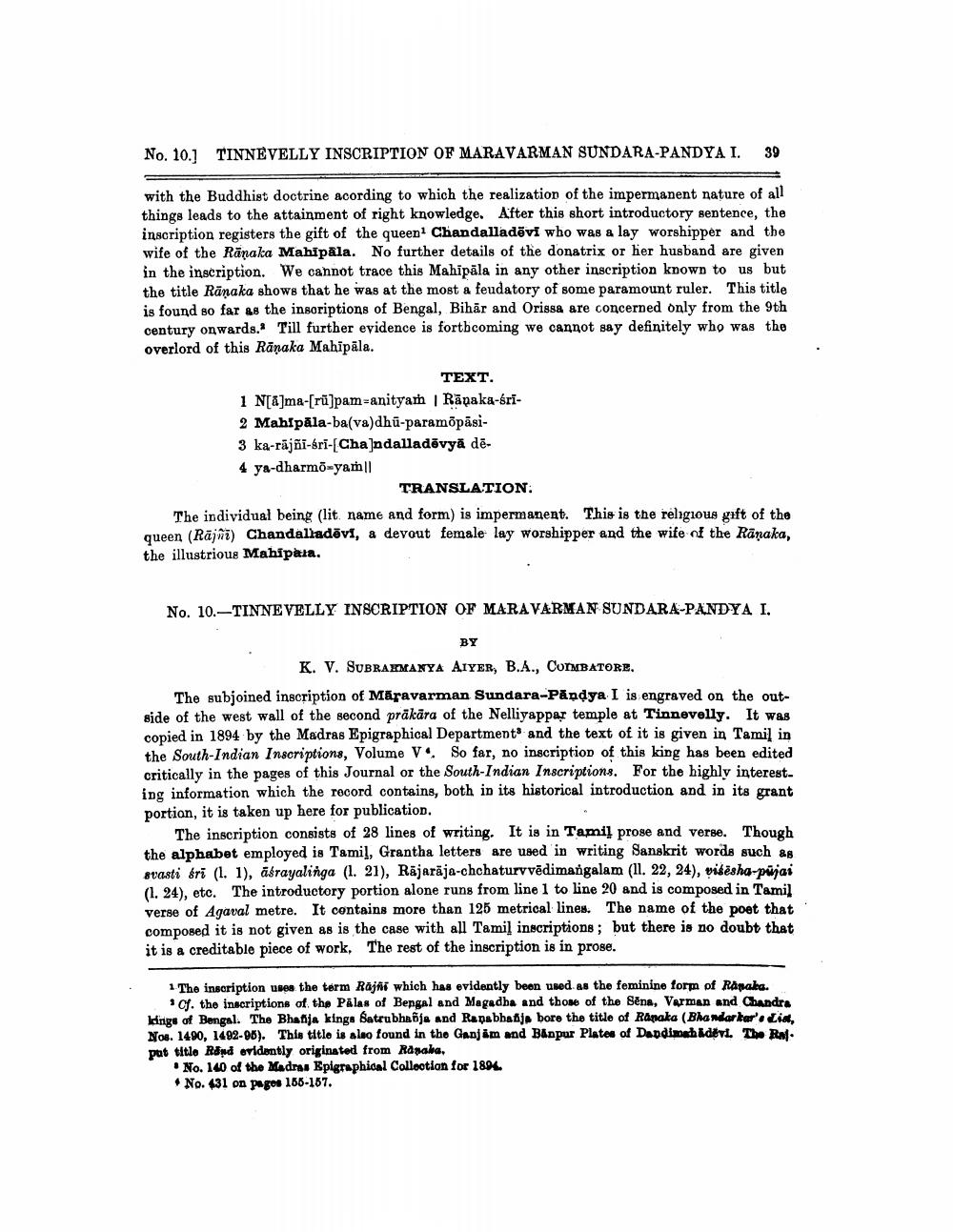________________
No. 10.] TINNEVELLY INSCRIPTION OF MARAVARMAN SUNDARA-PANDYAI. 39
with the Buddhist doctrine acording to which the realization of the impermanent nature of all things leads to the attainment of right knowledge. After this short introductory sentence, the inscription registers the gift of the queen Chandalladēvi who was a lay worshipper and the wife of the Rānaka Mahīpâla. No further details of the donatrix or her husband are given in the inscription. We cannot trace this Mahipāla in any other inscription known to us but the title Rānaka shows that he was at the most a feudatory of some paramount ruler. This title is found so far as the insoriptions of Bengal, Bihār and Orissa are concerned only from the 9th century onwards. Till further evidence is forthcoming we cannot say definitely who was the overlord of this Rāņaka Mahīpāla.
TEXT. 1 N[á]ma-[rū]pam=anityam Rāpaka-sri2 Mahipāla-ba(va)dhū-paramõpāsi3 ka-rājñi-sri-[Cha]ndalladēvyā dē4 ya-dharmõyam ||
TRANSLATION The individual being (lit. name and form) is impermanent. This is the religious gift of the queen (Rajwi) Chandalladēvi, a devout female lay worshipper and the wife of the Rânaka, the illustrious Mahipala.
No. 10.-TINNEVELLY INSCRIPTION OF MARAVARMAN SUNDARA-PANDYA I.
BY K. V. SUBRAHMANYA AIYER, B.A., COIMBATORE. The subjoined inscription of Māravarman Sundara-Pandya I is engraved on the outside of the west wall of the second prākāra of the Nelliyappar temple at Tinnevelly. It was copied in 1894 by the Madras Epigraphical Department and the text of it is given in Tamil in the South Indian Inscriptions, Volume V. So far, no inscription of this king has been edited critically in the pages of this Journal or the South Indian Inscriptions. For the highly interest ing information which the record contains, both in its historical introduction and in its grant portion, it is taken up here for publication.
The inscription consists of 28 lines of writing. It is in Tamil prose and verse. Though the alphabet employed is Tamil, Grantha letters are used in writing Sanskrit words such as svasti eri (1.1), ābrayalinga (1. 21), Rājarāja-chchaturvvēdimangalam (11. 22, 24), višesha-püjai (1. 24), etc. The introductory portion alone runs from line 1 to line 20 and is composed in Tamil verse of Agaval metre. It contains more than 125 metrical lines. The name of the poet that composed it is not given as is the case with all Tamil inscriptions; but there is no doubt that it is a creditable piece of work. The rest of the inscription is in prose.
1 The inscription uses the term Rajhi which has evidently been used as the feminine form of Rapaka.
. Cf. the inscriptions of the Palas of Bengal and Magadha and those of the Sena, Varman and Chandra kings of Bengal. The Bhanja kinga Batrubhapja and Ranabhafija bore the title of Ranaka (Bhandartar, Lin, Nos. 1490, 1492-98). This titlo is also found in the Ganjim and Banpur Plates of Dandimahidevi. The Ral put title Rand ovidently originated from Ranaba.
• No. 140 of the Madras Epigraphical Collootion for 1894 • No. 431 on pages 166-157.




